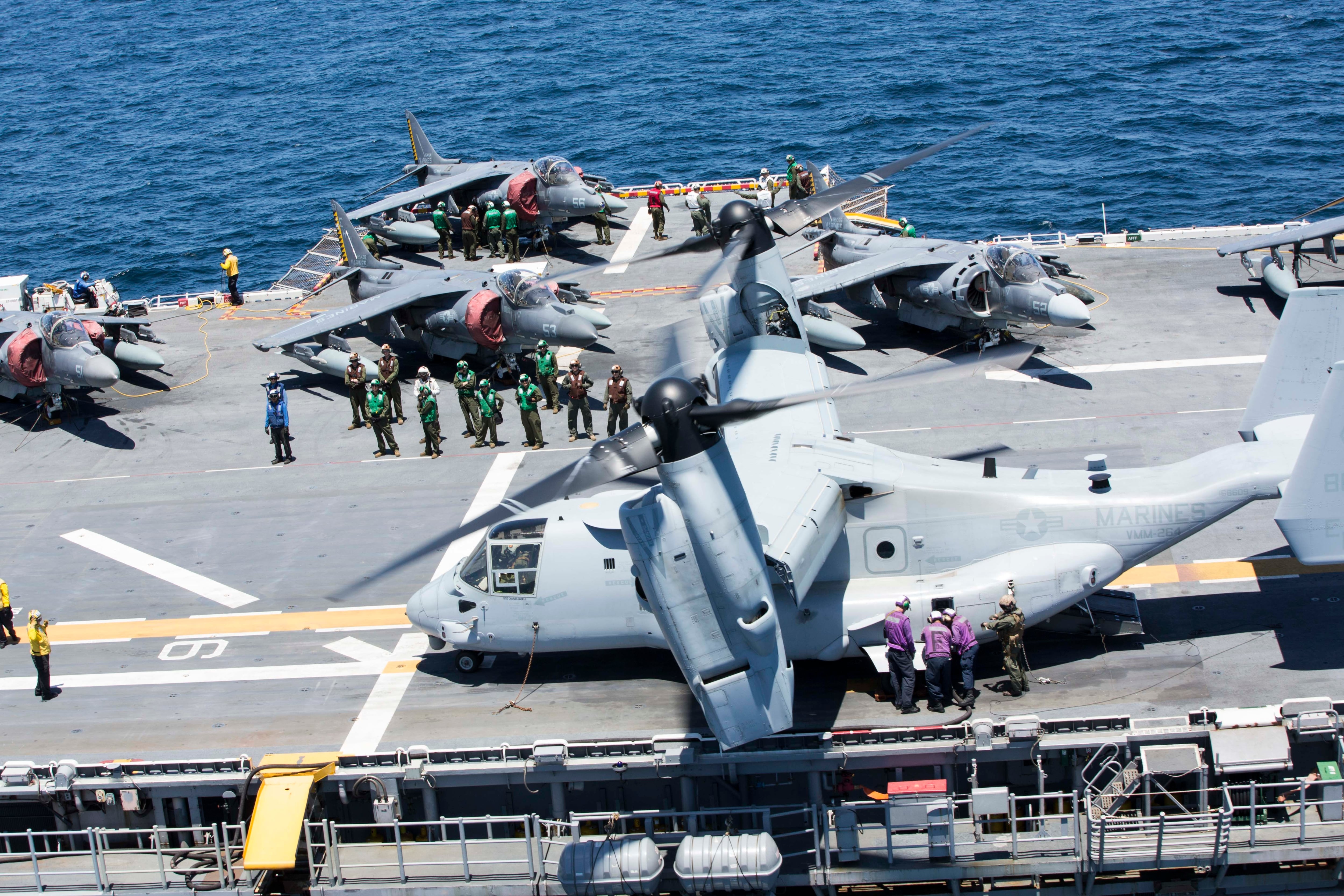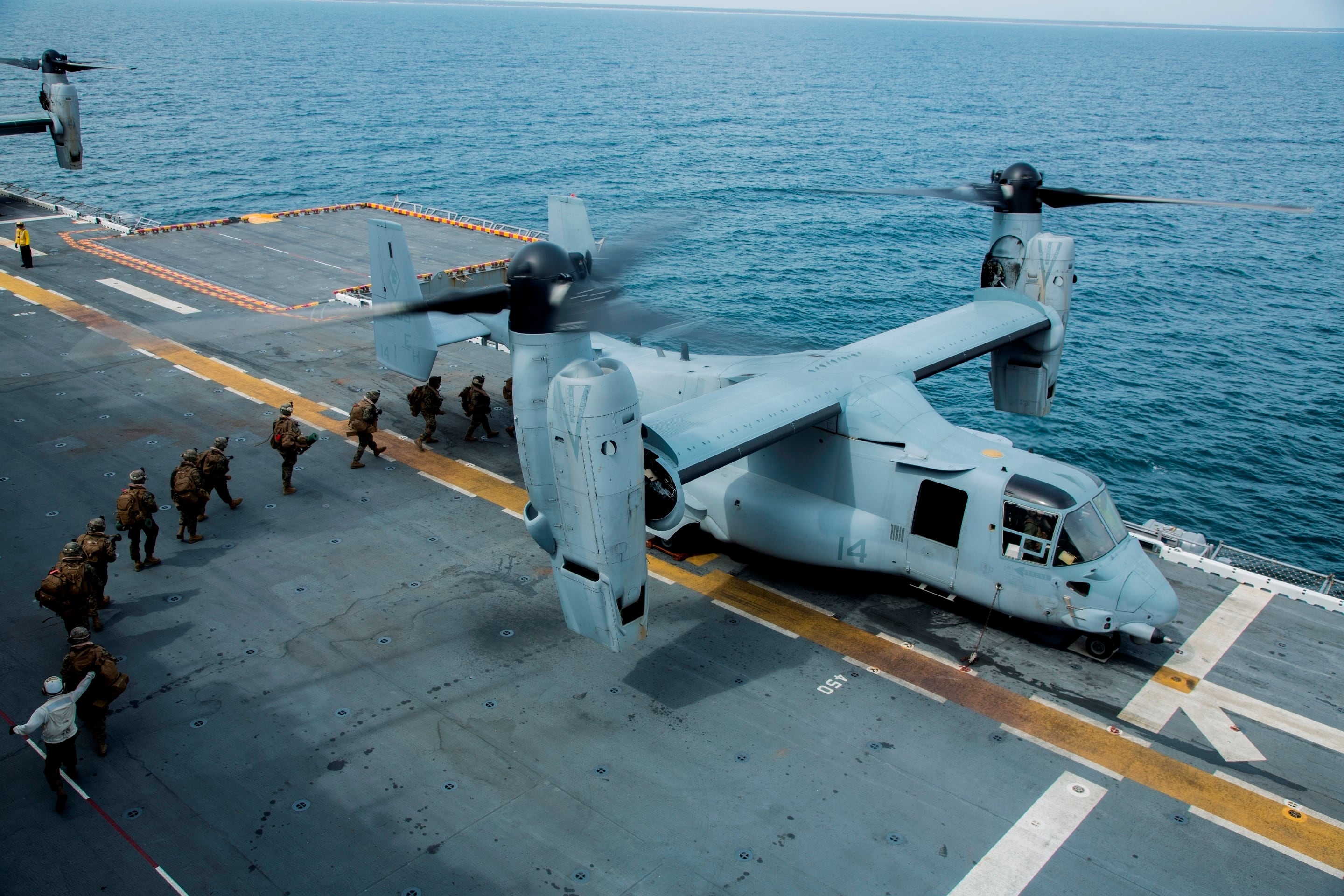ABOARD THE AMPHIBIOUS ASSAULT SHIP WASP — The Islamic State group is about to feel the sting of this 27-year-old gator as it heads out on its first major deployment in more than a decade. It's is a deployment of old salts as three first-of-class ships with a combined age of 68 years set sail Saturday for on a planned six-month pump to the Middle East Fifth Fleet.
The amphibious assault Wasp is back in the fight. For the first time in 11 years, the Wasp will deploy to the Middle East with the dock landing ship Whidbey Island and the amphibious transport dock San Antonio. The three ships in the amphibious ready group have a combined age of 68 years.
The ARG will carry more than 2,000 members of the Camp Lejeune, North Carolina-based 22nd Marine Expeditionary Unit, which includes Battalion Landing Team, 1st Battalion, 6th Marines; Combat Logistics Battalion 22; and Marine Medium Tiltrotor Squadron 264 (reinforced).
The sailors and Marines will take up the fight against ISIS during their six-month deployment.
"To think that we are going to go over to that part of the world and not be engaged in some of these fights against ISIS, don't be naïve," said Capt. Andy Smith, the ship's commanding officer. "We're going to launch aircraft off with weapons and they're going to come back having dropped them on somebody. If we have to send Marines ashore, they will be in the thick of it.
"That's the mindset you have to have — this is a warship, and it is going to war."
Though among the oldest in the Navy's fleet, the ships carry some of the service's newest sailors systems. The majority of crew members are on their first deployment — most weren't even in uniform the last time the the Navy Wasp last deployed.
But after some major upgrades, the gator is ready to take the Marines and sailors to combat.
"If we are called upon to fight, we are going to win," said Col. Todd Simmons, the 22nd MEU commander.
Off the sidelines
Though among the oldest in the Navy's fleet, the ships carry some of the newest sailors and systems. The majority of crew members are on their first deployment — most were not even in the Navy when Wasp last deployed.
Though the Wasp was showing its her age, it now she also sports some of the Navy's newest systems, including a state-of-the-art brand new ship self-defense support system.
The amphib's 1980s-era advanced combat direction system was a flop, and without Without a major fix combat system suite, the Wasp was dead in the water. Since 2004, the ship had been relegated to Fleet Week and goodwill port visits. A 2009 decision to forgo costly upgrades seemed to seal the ship’s fate.
But the Navy reversed course and upgraded the system as part of an extensive overhaul that kicked off started in 2014. Since then, the crew has even knocked out drones with everything from the close-in weapon systems to guided missile weapon systems.
Smith was commanding the Wasp when it got orders to get back in the fight. He has led the push to build a combat-ready ship and crew.

An MV-22B with Marine Medium Tiltrotor Squadron 264 (Reinforced) prepares to take off from the flight deck of the amphibious assault ship Wasp during a May training exercise.
Photo Credit: Cpl. John Hamilton/Marine Corps
The Wasp ship came out of the shipyard in late 2014 after an extensive maintenance availability. Adjustments were made to accommodate operational testing of the F-35 joint strike fighter. While that required a great deal of effort, it didn't compare with the preparation that went into this deployment. it was While the transition to JSF testbed required greater effort than seasonal dog and pony shows, that demand still fell far short of the demand faced in preparation for and execution of a forward deployment to the Middle East.
Even basic matters required upgrades. An assignment to Wasp has long meant little, if any, time at sea. This detrimental mindset was evident in the most basic matters. Since sailors did not process trash in the typical fashion. Because the ship had not been at sea for more than 14 consecutive days in five years, for example, sailors would stack their up trash in the waste-processing storeroom for easy disposal at port. That had to change.
The Wasp also lacks many of the modern creature comforts Marines and sailors might find aboard newer ships. There are no cards to swipe for access to the head, and flat screens are few and far between. There is only one gym to accommodate the crew and Marines, and the Corps. The decade-old galley design is a recipe for long chow lines. The list goes on.
But ahead, To shift the focus from Fleet Week to forward deployment, Smithand Simmons have pushed their sailors and Marines to get the amphib ready for its mission ahead. They delegated tasks to the lowest possible levels. And they asked for honest feedback from their troops.
If the Wasp was going to combat, they the lowest possible level. It is an attitude shared by his Marine counterpart, Col. Todd Simmons. Rather than a zero-defect approach, the 22nd MEU commander set a "relentless learning culture" that allowed shortfalls as long as they were used as stepping stones to improvement."We're never losing. We are either winning or learning," he said.needed He required thorough analysis and brutal honesty about anything that was going wrong. The two COs then in after action reports, and demanded improvement with every step. It is clear that his is a people-focused rather than gear-focused organization.
"You never know when this is the last opportunity to practice something, so we practice every one like it is the last chance before we go out the door," Simmons he said.
As the MEU assembled training plans to hone the Marines' ose skills, the Wasp’s crew spent much of 2015 at sea, running systems, busting the rust and getting to know the ship again. where they would run the systems, bust the rust, and get to know the ship again.
"Every ship is unique," the skipper said. "As they are blowing off the cobwebs, that invaluable knowledge of how the ship will act in certain circumstances had to be regained. You have to learn the tendencies of the boilers and engines, the electrical and combat systems; all of the idiosyncrasies that give the ship her own unique personality."
Firing up the engines
Lt. Cmdr. Joe Towles knows the Wasp well.
The mustang was a newly minted ensign aboard the amphib the last time it deployed. He reported back to the ship about two years ago as the main propulsion assistant. He's now the chief engineer.
Towles and his team have been lighting the Wasp's engines ahead of this deployment. The sporadic deployments went a long way in keeping things running smoothly, but the amount of Marines and sailors now aboard can stress the ship.
"We had to get sailors used to taking Navy showers, not an hour-and-a-half shower like they're at home," Towles said.
Towles is everything one might expect in an old-school hull maintenance technician — busted knuckles decorated in grease and grit. That experience will pay off as the ship is pushed to its limits in high temperatures while underway.
In fact, his spaces are already in a heat-stress condition, hitting 130 degrees on the blower flaps and temps in steady excess of 95 degrees plant-wide.
"It is only going to get hotter," he said. "Fifth Fleet is going to be nasty. I'm already telling these sailors to put the energy drink down, drink some water, eat something green and get some sleep."
Most of his 210-man team have never deployed. But he describes this "absolutely amazing" team as the best he has seen in his career. He has roughly half a dozen mustangs with loads of repair and contracting experience.
"My chiefs are chiefs," he said. "They have no problem walking through that door, kicking it off the hinges and saying 'Hey, we need to change how we are doing business because this ain't right.'"
Capt. Byron Ogden, commodore of Amphibious Squadron 6, said the crew is prepared for the challenges that come with operating aging ships.
"It might be an old ship, [but] … we make sure we get everything operating," he said. "It is older and things can tend to break, but we fix those things. Right now things are looking very good."
Building the partnership
The sailors and Marines kicked off their predeployment planning for this deployment back in December.
They were slated to conduct training and planning in Virginia, but the team decided to shift colors the last two days and transferred onto the ship. Ogden said the unorthodox move helped build cohesion among key ARG and MEU leaders. It also caught the attention of senior Navy and Marine leaders, and now there's talk of making that approach the new norm.
"The unity of the blue-green that we have put together is better than I have ever seen," Simmons said.

Members of Battalion Landing Team, 1st Battalion, 6th Marines board an Osprey while training on the amphibious assault ship Wasp. The unit will deploy aboard the Wasp with the 22nd Marine Expeditionary Unit on Saturday.
Photo Credit: Cpl. Ryan Coleman/Marine Corps
In March, the troops completed a two-week combined exercise centered on operational and tactical planning. The integrated training exercise followed, which gave the Marines and sailors the sea time needed to develop their battle rhythm. The Marines tackled armory and ammo procedures, mission staging and the driving of landing craft. The ship also fired its first missiles in more than a decade.
Certifications culminated with the grueling, three-week composite training unit exercise. The ship had barely cleared Naval Station Norfolk when hit with a simulated speed-boat attack. The tests the sailors and Marines faced only grew increasingly complicated from there.
The Marines are prepared for the likelihood of disaggregated operations, which have become increasingly common for ground forces. In the spring, the 26th MEU sent a company of Marines into Iraq to provide security at a base ahead of the Iraqi army's mission to retake Mosul. The MEU returned to North Carolina in early May, but the Marines in Iraq stayed in place for about another month.
The Marines prepared for such scenarios through realistic urban training, along with reconnaissance and surveillance training. They conducted raids and specialized insertion and extraction exercises.
In short, "we are extremely prepared," the commodore said. "We are ready to go out and beat the tip of the spear. We are ready to operate forward."




